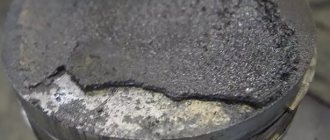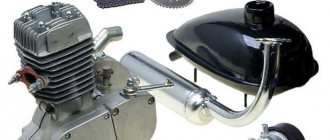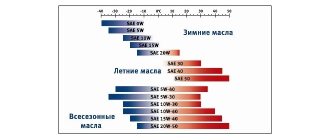Almost every owner of a private home has gasoline-powered assistants that make it easier to perform various tasks - cutting grass, sawing trees, removing snow. The units under consideration are dominated by internal combustion engines created by Etienne Lenoir in 1860. Modern petrol tools are equipped with internal combustion engines, which are divided into two main types - two-stroke and four-stroke. We will learn in detail from the material what is the difference between a two-stroke engine and a four-stroke engine, and what other types of gasoline engines are there.
What is an internal combustion engine on gas-powered tools?
An internal combustion engine is a unit that transforms fuel into mechanical energy. Today, internal combustion engines are used everywhere - from tools to cars and other types of equipment. The principle of operation of the internal combustion engine is due to the fact that a combustible mixture based on gasoline with air is supplied to the design. The carburetor is responsible for creating the desired consistency of the combustible mixture.
The combustible mixture is fed into the cylinder, where it is ignited. The combustion of the mixture creates useful energy that is removed from the crankshaft in the form of rotational movements. The main advantage of the internal combustion engine is that it has high power when compared with electric motors. Most gas-powered tools—trimmers, brush cutters, walk-behind tractors, chainsaws, etc.—are equipped with two-stroke internal combustion engines. More powerful petrol tools are equipped with a four-stroke internal combustion engine. What is the difference between two-stroke and four-stroke engines, what operating principle do they have, as well as their pros and cons are described in the material.
Scope of application
Separately, it should be noted that from the point of view of efficiency, a four-stroke engine is somewhat more profitable than a two-stroke engine. This is due to reduced fuel consumption, which is important given the current cost of fuel. Despite this, its significant dimensions make it possible to use such equipment only for large equipment, such as trucks, cars, buses, etc.
The small dimensions, complemented by the reduced weight of the unit, allow the use of two-stroke engines for mopeds, scooters, motorcycles and other small-sized devices. This motor model is also used in lawn mowers, motor boats, etc.
What is called a stroke in an internal combustion engine?
A stroke on an internal combustion engine is an action that takes place inside the mechanism. Moving the piston in the upper or lower direction is the stroke. Moreover, one stroke is when the piston moves upward, performing the corresponding work. The downward movement of the piston, which returns from the force generated by the combustion of fuel, is called the power stroke.
The first stroke from which the engine begins to operate is filling the cylinder with the fuel mixture. The next stage is the compression of the incoming mixture into the engine. Next, ignition occurs, and finally the removal of burnt gases. These are the four strokes that are performed in four-stroke engines. The crankshaft in four-stroke units makes two revolutions with one ignition of the fuel.
Two-stroke engines operate in two cycles - transporting the fuel mixture into the cylinder with its subsequent ignition, and removing exhaust gases from the cylinder. In two-stroke units, the crankshaft makes one revolution when burning one portion of the fuel mixture.
This is the main difference between the units under consideration and each other.
2-stroke and 4-stroke internal combustion engines are available in gasoline and diesel fuel types. To find out in detail what advantages and disadvantages are available in the 2- and 4-stroke engines under consideration, let us consider their design and operating principle.
Reliability of 2T and 4T engines
In a 2T engine, the piston, piston rings and cylinder are actually consumables due to the design features (there are holes in the cylinder).
Many scooter owners wear out a 2T engine piston in one season, and a cylinder in two. In a 4T engine - 4-5 seasons on one piston of a 4T engine.
Due to better lubrication (oil is supplied to critical parts not mixed with gasoline, but by splashing or supplying under pressure), the 4T engine is designed for a longer service life. A more complex valve mechanism for gas intake and exhaust works more clearly and requires simple and less frequent maintenance.
Two-stroke internal combustion engine, its design features and description of the operating principle
Most chainsaws and brush cutters are equipped with push-pull drive units. Two strokes are the stage of compression of the fuel mixture and the power stroke of the piston (when it goes down). To understand how a two-stroke engine differs from a four-stroke engine, let’s first consider the structure of the motor. The main parts of an engine are the cylinder, piston, crankshaft and connecting rod. The spark plug is responsible for burning the fuel, and the mixture is transported and gases are removed through the intake and exhaust channels. The design diagram of a two-stroke engine is shown in the photo below.
A two-stroke engine has a simplified structure in contrast to a four-stroke engine. Its operating principle is simple, and begins with the piston moving from bottom to top dead center. There are three holes in the cylinder walls - inlet, outlet and purge channel. The inlet is located lower than the outlet, and the purge is located between them, as shown in the photo above. The inlet and purge channel is connected to the crank chamber. Below is a detailed description of the principle of operation of the internal combustion engine.
First beat.
Initially, fuel from the carburetor is transported to the crankshaft chamber. Through the purge hole, the pre-entered fuel-air mixture is sucked into the cylinder from the crankshaft chamber. The supply of the mixture stops when the piston closes the hole in the purge channel. Next, the movement of the piston closes the exhaust channel. Part of the fuel-air mixture goes into the exhaust channel. After closing the exhaust channel, the process of compression of the combustible mixture begins. This mixture consists of gasoline, oil and air. When the piston reaches top dead center, the mixture ignites due to the creation of a spark from the spark plugs.
At the moment when compression occurs in the upper part of the cylinder, a vacuum is created in the lower part of the crankshaft chamber. This vacuum allows the next portion of fuel to be sucked from the carburetor for the next ignition. The fuel sucked into the chamber of the crank mechanism simultaneously lubricates the crankshaft and connecting rod. That is why special oil for a two-stroke engine is added to the combustible mixture. Two-stroke engines do not have an oil sump, which is one of their main differences from four-stroke engines. All these processes are carried out in one clock cycle.
Second beat.
The burnt gases push the piston down, thereby achieving a working stroke. When the exhaust port opens, exhaust gases exit through it and enter the muffler through a channel. The piston moving down creates pressure in the crankshaft chamber. Due to this pressure, the fuel-air mixture of the TPS is squeezed out of the crankshaft chamber into the purge channel. The next portion of TPS is pushed into the cylinder immediately when access to the purge hole is opened. When the working chamber of the cylinder is filled with a portion of the fuel mixture, the remaining exhaust gases are simultaneously displaced. The second stroke ends when the piston reaches bottom dead center.
The visual process of a two-stroke engine is shown in the animated image below.
This type of internal combustion engine has its advantages and disadvantages, which are described below. Knowing the structure and operating principle of a two-stroke engine, let’s look at four-stroke engines.
Four-stroke operation diagram
The essence of the mechanism of a four-stroke engine is an increased number of phases and valve activation. Thus, the working cycle of a 4-stroke carburetor engine takes place in 4 stages: in addition to compression and expansion, there is also intake and exhaust. Together with the intake, the piston moves from TDC to BDC. At this time, the camshaft cams ensure that fuel fluid enters the cylinder.
The return stroke of the piston compresses the liquid and raises its temperature. Before the compression itself, the candles form a spark that ignites the mixture. It burns and produces flammable gas, which pushes the piston down. When it is in the lower position, the exhaust valve opens. Through it, a rising piston pushes gases out of the cylinder. This is how the third beat proceeds - release. When TDC is reached, the valve closes and the whole cycle repeats from the beginning.
Four-stroke engine, its structure and how it works
Four-stroke units have a more complex structure, but at the same time they are characterized by high performance and a long service life. Their work consists of 4 cycles, as mentioned above. This is the intake stroke of the fuel mixture, its compression, power stroke and release of burnt gases. Unlike two-stroke engines, 4-stroke engines have an oil sump, through which rotating and rubbing parts are lubricated. To understand what we are talking about, below is a diagram of the structure of a four-stroke internal combustion engine.
The diagram above shows the main structural elements of a 4-stroke internal combustion engine:
- Cylinder - the base in which the piston moves
- The piston is the main working element of all internal combustion engines. The piston has rings through which the fuel mixture is compressed
- Connecting rod - connecting element between the crankshaft and the piston
- Crankshaft - located in the crank chamber
- Connecting rod pin - connecting element between the crankshaft and connecting rod
- Combustion chamber - in this chamber the fuel is compressed and ignited
- Intake valve - when it opens, the fuel mixture from the carburetor enters the combustion chamber
- Exhaust valve - opens to remove exhaust gases from the combustion chamber
- Spark plug - ignites the fuel mixture
The operating principle is similar to two-stroke engines, but there are some distinctive features. Let us next consider the principle of operation of a four-stroke engine in cycles.
First beat.
The air-fuel mixture is transported into the combustion chamber when the intake valve opens. The piston is at top dead center. The valve is opened by means of the cams of the gas distribution mechanism. The fuel mixture is sucked in until the piston reaches bottom dead center. The crankshaft makes half a revolution.
Second beat.
It begins with the piston moving from bottom dead center to the top. In this case, the fuel-air mixture received at the previous stage is compressed. Once the piston reaches top dead center, a spark is generated by the spark plug. Along with the first stroke, the crankshaft makes one revolution.
Third beat.
The pressure generated by the combustion of the mixture ensures that the piston moves from top dead center to bottom. This movement of the piston after combustion of gases is called the power stroke. The exhaust gases in the third stage remain in the chamber until the piston reaches bottom dead center. After this, the final stage begins.
Fourth measure.
The piston moves from bottom to top dead center, thereby releasing the combustion chamber from the exhaust gases contained in it. To do this, the exhaust valve opens, which is also connected to the gas distribution mechanism using a cam. After this, the cycle repeats.
An animated representation of the working principle of a four-stroke engine is shown in the diagram below.
Four-stroke engines are more advanced, durable and reliable compared to two-stroke engines.
Which engine is more powerful: 2 stroke or 4 stroke?
Unlike a 4 ton engine, in which one power stroke occurs per two revolutions of the crankshaft, in a 2 ton engine, a power stroke occurs with each revolution of the crankshaft. This means that a two-stroke engine must have (in theory) twice the liter power (ratio of power to engine displacement) than a four-stroke engine. But in practice the predominance is only 1.5 - 1.8 times. This happens due to inadequate use of the piston stroke during expansion, a worse mechanism for ridding the cylinder of exhaust gases, the consumption of a share of power for purging and other phenomena associated with the distinctive features of gas exchange in 2-stroke engines.
The main differences between two-stroke and four-stroke internal combustion engines
One of the main differences between the units under consideration is the presence of a gas distribution mechanism on a 4-stroke engine. There is no gas distribution mechanism on 2-stroke devices. Instead, there are holes in the cylinder walls, through which the finished fuel-air mixture is supplied, as well as exhaust gases are removed.
The timing belt not only increases the weight and size of the engine, but also significantly affects its cost. The absence of a timing belt results in the engine having only two operating cycles. The presence of channels in the cylinder walls leads to increased wear of the engine rings and piston. This is why two-stroke engines have a short service life. Next, let's look at the design differences between 2-stroke and 4-stroke engines.
- Fuel consumption - despite the fact that the two-stroke unit has a simple structure, in terms of gasoline consumption it is inferior to the four-stroke unit.
This is due to the number of cycles. While a 4-cycle unit makes 2 revolutions of the crankshaft, consuming one portion of fuel, a two-stroke engine makes only one revolution. The increase in fuel consumption is approximately 1.5 times. In addition, do not forget that the 2-stroke unit has an imperfect system, and during operation there is a loss of the fuel mixture released into the muffler. This is part of the mixture that “flies into the pipe” when the piston moves upward at the moment of compression - Fuel type - 4-stroke engines run on pure gasoline, which is mixed with air in the carburetor
. 2-stroke units operate on a mixture of oil and gasoline. The use of pure gasoline is unacceptable, which will lead to rapid failure of the cylinder-piston group - Lubrication system - many people know that it is by this principle that the units in question differ.
The 4-stroke engine has a separate lubrication system, consisting not only of a container, but also an oil pump, filters and a pipeline. The lubrication system is not interconnected with the fuel supply mechanism, which indicates not only efficiency, but also a long service life. Two-stroke engines run on gasoline and oil. The proportions for mixing gasoline with oil for chainsaws and lawn mowers are described on the website. Gasoline along with the fuel is supplied to the engine, where the mechanism is lubricated. It is worth noting that not all two-stroke engines have a common lubrication system, but there are also units with a separate mechanism, where mixing occurs automatically depending on the number of revolutions - Type of lubricants or the difference between oil for a two-stroke engine and a 4-stroke one.
For two-stroke engines, special “burning” type oils are used. This oil is mixed with gasoline and enters the crankshaft system, providing lubrication to moving parts. After this, the oil, combined with gasoline, enters the cylinder, where it ignites and burns. This oil is called two-stroke oil, and it comes in red or green. Color does not play a big role, and indicates the use of additives in the composition. Four-stroke engines run on pure gasoline, since they have a separate mechanism responsible for lubricating the crankshaft. Such engines use regular motor oil, which cannot be mixed with gasoline and poured into two-stroke units. This will lead to rapid clogging of the spark plug electrodes and failure of the internal combustion engine. It turns out that the difference between oil for two-stroke engines and four-stroke engines lies in consistency and composition. 2-cycle internal combustion engines use combustible types of oils, which lubricate the entire system before burning
Regarding the lubrication system of four-stroke engines, it should be noted that they come in two types - dry and wet sump. They differ in the method of lubrication. In the wet type, oil is supplied from the crankcase to the crankshaft. The pump pumps oil from the crankcase, which is part of the engine.
Dry sump internal combustion engines use a separate oil tank. From it, oil is pumped into the crankshaft system, ensuring lubrication of the parts. The accumulated oil is transported back to the tank using an additional pump.
Knowing the main design and fundamental differences between the mechanisms under consideration, you should understand their advantages and disadvantages, which both options have.
Lubrication principle
These two engine samples differ in their lubrication features. 2T engines require a combination of motor oil and gasoline in specific ratios of 1 to 50. The oil lubricates the crankshaft and connecting rod bearings during circulation and burns along with the fuel. Combustion products are removed along with exhaust gases.
There are two methods to mix gasoline and oil. One is mixing immediately before pouring into the tank, the second is feeding separately, in which the liquids are mixed already in the nozzle. For separate supply, the motor is equipped with an oil tank. In this case, the pipeline is connected to the pump and receives the exact amount of oil required.
Separate feeding reduces smoke, reduces carbon deposits and reduces oil consumption.
Four-stroke engines do not require mixing - gasoline and oil are supplied separately. Such motors have a standard lubrication system, which includes: a pump, valves, special filters, and pipelines. Instead of an oil tank, the engine crankcase can be used.
Parts have their own wear products, and special filters are used to clean the oil. If the oil temperature rises above normal, install cooling radiators.
Pros and cons of internal combustion engines
First, let's look at all the existing advantages and disadvantages of two-stroke engines, which, despite their design, are very popular. Their advantages include:
- Simplicity of design
- High speed of acceleration
- Low cost, which makes tools equipped with such units very popular
- Ease of maintenance due to the absence of a timing belt and a separate lubrication system
- Light weight and dimensions, which makes tools with such internal combustion engines convenient and practical
Now let's look at all the disadvantages that two-stroke engines have:
- Noisy operation
- Low environmental friendliness, which is due to the release of unburned fuel into the atmosphere
- Low work resource
- The need to mix gasoline with oil at every refueling. In addition, diluted fuel cannot be stored for a long time, otherwise it will spoil.
- High fuel consumption
- Low power compared to four-stroke
4-stroke units have many more advantages, however, disadvantages such as design complexity, heavy weight and price leave a negative imprint. Not everyone can afford to buy, for example, a snow blower with a 4-stroke engine, which costs 2 times more than an analogue with a more primitive unit. All the disadvantages of 2-stroke engines are the advantages of four-stroke engines.
Due to the large number of shortcomings of both types of engines, manufacturers have patented the production of modernized internal combustion engine models, which are called 4-MIX and 2-MIX. Surely you have encountered the fact that when repairing or replacing engine parts of a chainsaw or lawn mower, the presence of a timing mechanism was discovered, but the tool is filled with diluted gasoline and oil, as indicated by the manufacturer. That's right, this means that your instrument is equipped with a 4-mix motor. We will learn more about these types of engines below.
Efficiency of 2T and 4T engines
For example, a 50 cc 2T model with decent performance (power 4-5 hp) consumes 3.5 liters of gasoline per 100 km. oil, and a 4T engine with a power of 3 hp. “will eat” 2.2 liters. gasoline. Almost no oil is consumed at all.
Fuel consumption affects not only the speed at which your wallet is emptied, but also your mileage at one gas station. Since the tanks of scooters are approximately the same, a 6 liter tank of a 4T scooter will be enough for you, 100 km more.
The environmental situation in the world, especially in Europe and America, forces the governments of all countries to take measures to tighten control over emissions, noise and other parameters of equipment produced or imported into these countries. For this reason, two-stroke engines are becoming a thing of the past.
Only on a 4-stroke engine is it possible to meet competitive prices and comply with EURO standards. Therefore, manufacturers are reducing the production of two-stroke engines - with them it is more difficult to obtain a certificate of conformity, European approval, and, therefore, to enter the market of developed countries. The production of 2T engines is still large, but scooters with such engines go mainly to developing countries. Now there are developments of 2T engines that meet all environmental standards, but their serial production is still far away. They won't be cheap either.
What is ICE 4-mix and what is it intended for?
If you are wondering what a 4-mix engine is or why the Stihl lawn mower is fueled with a gasoline-oil mixture, but the instructions indicate that it is four-stroke, then this is where you will find the answer. Stihl has patented a new type of engine called the 4-MIX. Its peculiarity is that it combines the advantages of two-stroke and four-stroke engines. How this type of engine works, and the most interesting thing is how the lubrication of the crankshaft is ensured, we will find out in detail. Below is a diagram of a 4-mix internal combustion engine.
The diagram shows that such an engine is equipped with a timing belt, and the unit operates in 4 strokes. At the same time, in order to save on the cost of gasoline tools, manufacturers do not use a separate lubrication system. The crankshaft lubrication is carried out together with fuel, as is typical for two-stroke engines. Gasoline and oil enter the crankshaft chamber from the container where the rocker arms of the intake and exhaust valves are located.
This container is connected to the crankshaft chamber using channels in which valve guides are located, one part connected to the rocker arm, and the other to the cam on the camshaft.
The air-fuel mixture from the carburetor is sucked into the sealed valve chamber and sent through channels to the crank mechanism. To have an idea of how the 4-mix internal combustion engine works, let’s look at the step-by-step operation of each stroke.
- The first stroke begins with the piston moving down from top dead center, simultaneously sucking in a portion of the fuel-air mixture through the opening intake valve. This mixture is sucked from the carburetor and valve chamber. The downward moving piston creates pressure in the crankshaft chamber, which allows the accumulated fuel-air mixture to be squeezed out through the channels of the guide valves. As a result, the cylinder is filled with a mixture of gasoline, oil and air.
- When the piston reaches its lowest point, the process of compressing the fuel begins. The mixture is ignited by a spark created by the spark plug as soon as the piston reaches top dead center. While the mixture is compressed in the cylinder, a vacuum or vacuum is created under the piston. Due to the vacuum, the next portion of fuel is sucked from the carburetor into the crankshaft chamber through the valve container. The mixture entering the KShM chamber lubricates the working parts
- After fuel combustion, the piston moves downwards - a working stroke occurs. At this time, pressure increases under the piston, which pushes the sucked mixture back into the valve chamber. The mixture cannot fill the working part of the cylinder, since the intake valve is closed. Excess pressure causes the mixture to be pushed back into the carburetor in some quantity. This results in air filters often being wet on 4-mix engines. This is not a problem with the carburetor at all, but a normal phenomenon. The amount of mixture ejected is not as large as on two-stroke engines, where the mixture is pushed out through the exhaust port. In addition, the fuel that settles on the filter is not released into the atmosphere, but condenses and is sucked back into the engine. The power stroke or third stroke ends when the piston reaches bottom dead center.
- The final stage is the opening of the exhaust valve. The burnt fuel is forced out through the valve in the form of exhaust gases. A vacuum is again created under the piston, as a result of which the next portion of the fuel-air mixture is sucked in from the carburetor entering the crankshaft chamber
This is how 4-mix internal combustion engines work, which have become very popular. Among the advantages of such motors, the following factors should be highlighted:
- Almost complete combustion of fuel, which has a positive effect on toxicity standards
- Simple lubrication system eliminating the need for an oil sump and pump
- Reduced weight, which is slightly more than a two-stroke unit weighs
- Reduced noise level compared to two-stroke engines
- High power
- Low fuel consumption
- Good acceleration and traction
This is interesting!
Petrol-powered tools from Stihl, equipped with a 4- mix internal combustion engine, have an improved starting system due to the use of a decompression mechanism. This system is implemented by slightly opening the intake valve during start-up. The valve is opened slightly using a metal protrusion on the cam of the timing mechanism. The decompression system works only when the engine is started, and when it is already running, the tongue is hidden in the cam due to centrifugal force.
As a result, Stihl managed to combine all the advantages of 4-stroke and 2-stroke engines, creating a unit called 4-mix. Simplicity of design, unpretentiousness, affordable cost, high power and other advantages are inherent in this modern type of internal combustion engine.
Differences in oil
The fundamental difference between the lubrication of one and the second engine is that the oil for a two-stroke engine is diluted with gasoline and ultimately burns along with the mixture. If we consider the four-stroke version, then it avoids by all means the ingress of oil into the chambers intended for fuel combustion. The conclusion from this is that for a four-stroke unit, oil is used that has a full range of lubricating properties over a long period of time, and for the second, it is important that no soot remains after the oil and that it completely burns together with the fuel.
As a result, two-stroke and four-stroke engines are different in many ways, both in the principle of operation and in the features of use. Ask any questions you have in the comments and share your opinion.
Source
What are 2-MIX and X-torq internal combustion engines
Stihl also offers gasoline tools with an upgraded two-stroke engine. This engine is called 2-mix - an improved two-stroke model. A similar engine model was released by Husqvarna, and called it X-torq. The operating principle of the engines is the same, and the differences are only in the design. The operation diagram of the ICE 2-MIX is presented below.
The diagram shows that the fuel-air mixture coming from the carburetor is divided into two streams. The green arrow shows the mixture, which is sucked into the crankshaft chamber, thereby lubricating the parts. Its suction occurs during the upward movement of the piston, when a vacuum is created. The mixture flow, indicated by the blue arrow, is fed directly into the cylinder chamber, where it is compressed and ignited. The suction of the fuel-air mixture into the cylinder occurs when the piston moves downward. What is remarkable about this engine operation scheme?
Flow separation made it possible to reduce emissions of the fuel mixture into the atmosphere released along with exhaust gases. This is achieved due to the fact that the working area of the cylinder is filled with a mixture enriched with air. This air pushes the exhaust gases, and in some quantity is also removed from the combustion chamber. A flow more saturated with fuel enters the crankshaft chamber, providing effective lubrication of parts.
As a result, the modernization of the two-stroke engine contributed to the fact that fuel losses were reduced, and therefore consumption decreased. In addition, the exhaust has become cleaner, since there is no gasoline and oil in the mixture, and the crankshaft system has received a more efficient lubrication system. Moreover, the cost of such an engine is not much different from a conventional two-stroke one. The operating diagram of this type of unit is shown in the video.
Are there any special fuel quality requirements for a regular two-stroke engine and a 2-mix? There is no difference, in addition, the same types of carburetors are used on such engines. The only difference between the carburetor is the presence of an additional spacer, through which the flow of the fuel mixture is separated on 2-MIX engines.
To summarize, it should be noted that there are differences between the types of engines under consideration, and they are quite significant. However, less reliable 2-stroke units continue to be actively popular due to their simple design and low cost. Knowing the design and principle of operation, it will not be difficult to repair the engine of such tools as chainsaws, brush cutters, walk-behind tractors, snow blowers, boat motors and others.
Compression - 4-stroke engine
The piston of a four-stroke engine rises from BDC to TDC, compressing the working fuel mixture. At the same time, the temperature of the combustible mixture rises significantly. The ratio of the working volume of the cylinder at BDC to the volume of the combustion chamber at TDC is called the compression ratio (not to be confused with compression). The compression ratio is a very important parameter; usually, the higher it is, the greater the fuel efficiency of the engine. But a four-stroke engine with a higher compression ratio requires fuel with a higher octane number, which is more expensive.
Two stroke outboard motor
So much good and bad has been said about outboard motors with a 2-stroke operating principle that only a lazy motorboat owner does not know about it. A two-stroke engine operates in two piston strokes, which are obtained per revolution of the crankshaft.
HOW DOES IT WORK? The entire working process of a 2-stroke engine consists of a compression stroke and a combustion stroke. As a result of the fire, the air-fuel mixture ignites and the crankshaft begins to move, after which the exhaust is pushed out of the cylinder.
Exhaust gases are removed simultaneously with a new portion of engine charging. Such a friendly cleaning and power supply of a 2-stroke outboard motor is called purging. And the main principle of the unit is its refueling, which consists of pre-mixing oil and gasoline.
A two-stroke outboard boat motor is the most common option offered to domestic shipowners by the water motor market. Due to the economical production of these units with good power indicators, Chinese manufacturers are actively supplying 2-stroke models of different power and configuration options.











